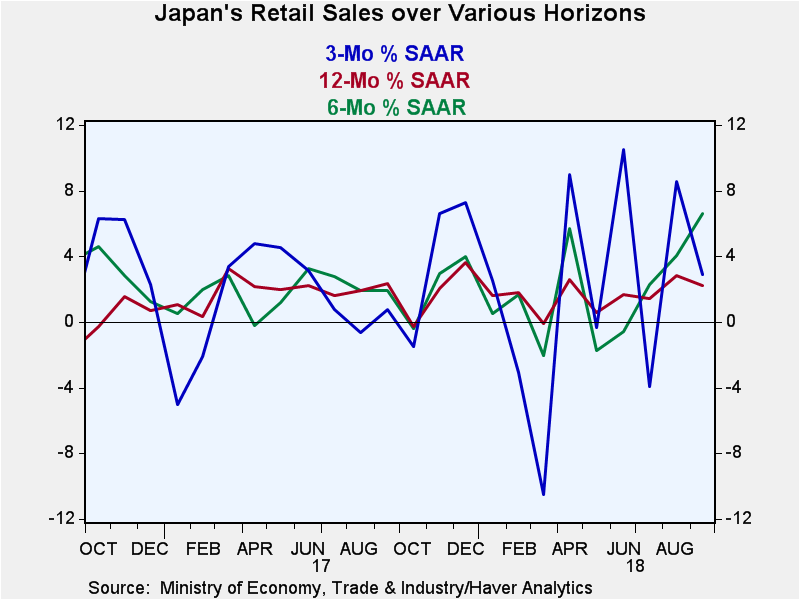 Global| Oct 29 2018
Global| Oct 29 2018Japan's Retail Sales Turn Choppy and Fall in September
Summary
Even Japan’s three-month growth rate series shows exceptionally choppy retail sales performance (see Chart). Year-over-year sales creep higher. Six-month trends show robust gains. The truth of trend lies buried somewhere in these very [...]
 Even Japan’s three-month growth rate series shows exceptionally choppy retail sales performance (see Chart). Year-over-year sales creep higher. Six-month trends show robust gains. The truth of trend lies buried somewhere in these very different statistics.
Even Japan’s three-month growth rate series shows exceptionally choppy retail sales performance (see Chart). Year-over-year sales creep higher. Six-month trends show robust gains. The truth of trend lies buried somewhere in these very different statistics.
While sales have fallen in September leading to some concern about the impact on quarterly GDP, total sales and sales by economic group for the most part show ongoing gains.
In real terms, the trends look a lot as they do in nominal terms but pitched at a lower rate of growth. Over 12 months, retail sales gains are at 1%; they have been stronger than 1% only twice over the past nine months in terms of their year-on year growth. Over six months, sales appear strong mostly because six months ago sales were exceptionally weak. The six-month growth rate is calculated on a very favorable basis this month.
While retail sales are up at a 2.4% pace in the just-completed quarter (see quarter-to-date in the table), they also are lower at a -0.3% annual rate in real terms because the CPI flared in the quarter.
Still, real retail sales trends in Japan are as hard to pin down as their nominal counterparts. Three-month real sales growth is at +0.1%, compared to +4.8% in August and to -5.5% in July. Japan’s retail sector has seen in a state of turmoil. And while there have been typhoons and weather events, the variability in retail sales for the nation as whole has simply been unusual. The year-on-year trend for real sales is steady but positive at a low rate of growth. Japan is probably still stuck in that low growth profile. And there is little doubt that the profile will be threatened by the ongoing trade wars since Japan trades most heavily with China and second most heavily with the U.S. Growth is in gear but nothing is assured.
Globally, growth is challenged. Mario Draghi is downplaying the European slowdown. China is fighting off slowdown effects dipping deeply in the well of debt as U.S. tariffs threaten. U.S. inflation after ‘flaring’ back to target is on the verge of undershooting again (so much for allowing overshooting). Some Fed policy officials think U.S. growth is becoming more durable. We will see how that plays out as the U.S. economy gets farther from the impact of extra spending to rebuild after hurricane damage and as the fiscal boost diminishes. Meanwhile, globally policy makers are taking growth for granted despite lack of inflation pressure and the presence of a broad-based slowdown. Should this slowdown and the threats to growth be taken more seriously? We are on the verge of finding out.

Robert Brusca
AuthorMore in Author Profile »Robert A. Brusca is Chief Economist of Fact and Opinion Economics, a consulting firm he founded in Manhattan. He has been an economist on Wall Street for over 25 years. He has visited central banking and large institutional clients in over 30 countries in his career as an economist. Mr. Brusca was a Divisional Research Chief at the Federal Reserve Bank of NY (Chief of the International Financial markets Division), a Fed Watcher at Irving Trust and Chief Economist at Nikko Securities International. He is widely quoted and appears in various media. Mr. Brusca holds an MA and Ph.D. in economics from Michigan State University and a BA in Economics from the University of Michigan. His research pursues his strong interests in non aligned policy economics as well as international economics. FAO Economics’ research targets investors to assist them in making better investment decisions in stocks, bonds and in a variety of international assets. The company does not manage money and has no conflicts in giving economic advice.






